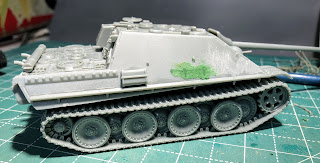Normally those titles means my wife has projects for me. This time its a project for me. While I was going through the last round of weathering on the U304(f)s I was continually misplacing the different bottles of what ever I was working with at the time. Mostly because I have managed to create three distinct work areas across the long counter in the workroom, which I must point out I share with my wife. In addition to misplacing things on a regular basis I tended to leave my tools spread across said counter as well. So its time to do something about it.
I have always been fascinated by the spinning ranks for tools, paints and such but I needed something a bit more compact than what seems to typically be available. I envisioned two different sized spinners; 6" and 5" in diameter. Two different sizes seems excessive but the requirements deem that necessary. I have four items that I want to use these for; tools (including paintbrushes), the standard dropper paint bottle, the Oilbrushers (from Ammo by Mig), and the larger bottles that most pigments and enamel paints come in. Micro Mark has a tool spinner that's the right size so I'm using that as the model. The 5" version can handle three of the hole sizes I need; 1/2", 3/4" and 1". The 1/2" spinner will have 16 holes which should handle most of my tools and brushes, I'll make two of these. For the 3/4" and 1" I can only fit in 8 holes of each size comfortably. I'm planning to make 3 of the 3/4" spinners which, like the tools, will only have a single level. For the 1" I'm planning on two spinners each of three levels so they will hold 24 bottles of paint each for a total of 48 paints in a small area. The 6" spinner will have the larger 1 3/8" holes and again will hold 8 bottles on each level and I'm planning on three levels.
For this first run I'm using Baltic Birch plywood, if I had a planer I would use something else because I have discovered that plywood tends to splinter when I use the big paddle blade style drill bits. While the 5" spinners can all be made from 1/2" plywood the levels for the 6" spinner need to be made from 1/4" plywood. I can drill the holes all the way through the top piece and then glue a bottom piece to it. First because I couldn't find a paddle blade the right size but I did have saw toothed drill bits but with these you can't just drill down a 1/4" and stop like a paddle blade you have to be able to cut all the way through and then pull the "plug" out of the bit. Its a pain when you are doing drilling so many holes but I'm happy with the result.
At this point all the pieces for the 6" spinner are drilled and glued together and the pieces for the 5" spinner with the 1/2 holes are drilled as well. I had started the 3/4" holes but ran out of time. After I finish the holes I will cut out the circle on the band saw and then figure out the best way to mount the different levels together. Dowels are the obvious answer but the width of that center hole needs to be determined, and I'm thinking that something a bit more decorative would be nice. I won't actually assemble anything till after I have applied some finish so I have a little time to think about it.
The spinners themselves are relatively inexpensive, I'm currently looking at 4" spinners that come on a square base which should fit under both the 5" and 6" spinners.
Here's some pictures so you can skip the rambling
 |
This will be a six inch spinner. All 8 holes have been drilled and the bottom has been glued on (with five clamps, one in each corner and another in the center, I need more clamps).
|
 |
Loaded up with eight of the larger bottles in my collection
|
 |
You can see the line for the final shaping cut here. Hopefully a steady hand will yield something that at least looks like a circle in the end.
|






















































